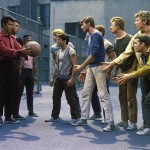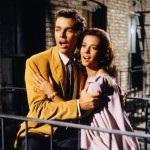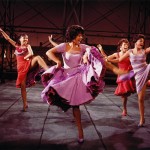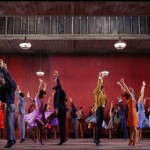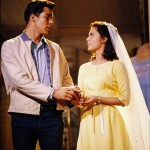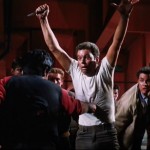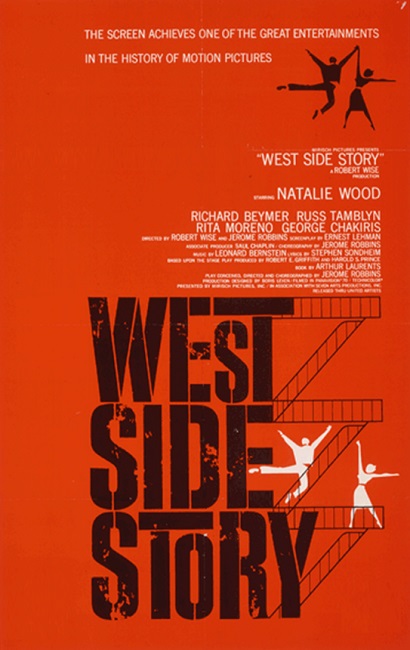
West Side Story – 1961
OK – this is going to be a difficult review for me. It has been my goal to be as objective as possible in my reviews, and though I know I am not always successful, I do my best. West Side Story is a film that I have seen more times than I can remember. I am a fan of musicals and this show has always been one of my favorites, largely because of the movie. I have enjoyed watching it since I was a child. How can I be objective?
This was an incredible movie, well worth the Best Picture award. The word that keeps coming to mind is GENIUS. And I associate that word with three aspects of the film. First is the music. Leonard Bernstein’s score is one of the best scores ever written for the musical genre. It covers the entire spectrum of emotions so perfectly that it tells the story nearly as well as the actors. Second are the lyrics. Stephen Sondheim is widely considered one of the most talented lyricists of the twentieth century. His words are always appropriate and specific to the character singing them. And third is the choreography. The dancing in this movie is beyond incredible. The phenomenal dance moves actually have a huge part in telling the story. But I’ll look at these three things more closely later.
I do have to mention one thing that I always notice when watching this movie: something I don’t care for. The actors are all wearing a ton of makeup – especially the characters who are supposed to be Puerto Rican. There are plenty of close-ups in the film, making the heavy makeup painfully obvious. But that is easy to get past. There are so many other things going on to distract you from that one minor problem.
The story is a modern (at least for 1961) telling of Shakespeare’s Romeo and Juliet, and it follows the original story remarkably well. The two lovers become Tony and Maria, played by Richard Beymer and Natalie Wood. These two are primarily singing parts with light dancing. Also in the film are Russ Tamblyn, Rita Moreno and George Chakiris, playing the parts of Riff, Anita and Bernardo, respectively. These are dance parts, and boy, were they challenged – Moreno and Chakiris in particular.
Of course, West Side Story was a stage musical before it was made into a film and I found that there were a number of differences between the two. For example, there are several places in which the lyrics were changed for the film to tone down some of the raciness. Another example is the character of Ice played by Tucker Smith, who was written specifically for the film. The addition of this character had the effect of changing the dynamics among the gang members.
Also, several songs were moved to different places in the show to assist with the pacing of the action. For the most part, I found that the changes that were made for the movie actually improved the show significantly, especially the order of the songs. They made much more sense within context of the plot.
One of the best changes that was made was in the song America. In the stage show, this song was sung by just the Sharks’ women. In the film the men were added to the number. It made just as much sense and added a new element to the dance number. It also added another level of complexity to the relationship of Bernardo and Anita, as the back and forth bickering in the song is mostly between them.
Interesting note: In the stage show, it is A-Rab who gets beaten up by the Sharks at the beginning, before the free-for-all breaks out between the two gangs. In the film, it is Baby John who gets chased and beaten up after being caught changing some wall graffiti from “SHARKS” to “SHARKS STINK”. It is interesting, that as David Winters played Baby John in the stage show and A-rab in the film, he avoided being chased and beaten-up both times.
Another interesting note: Elvis Presley was originally approached for the role of Tony. However, his manager, Colonel Tom Parker, strongly believed the role to be wrong for Elvis and made him decline in favor of other movie musicals. According to legend, the Colonel didn’t want Elvis associated with gang warfare and knife crime. After the incredible success of West Side Story, Presley regretted turning down the role.
So, let’s take a closer look at those three aspects of genius associated with West Side Story. Bernstein’s music was truly inspired. I believe this was some of his best work, and that is saying a lot for the prolific composer. The score was so memorable that some of the songs have become staples of American pop culture. The songs One Hand, One Heart and Somewhere are used over and over again for weddings. America and Tonight are instantly recognizable hits. Even songs like Gee, Officer Krupke and I Feel Pretty are fun songs that are beloved by anyone who knows musical theatre. The score is exciting and full of energy and is a pleasure to listen to.
Sondheim’s lyrics are pure gold. One of the challenges that a lyricist faces is differentiating the characters so that words are appropriate to the character singing them. Sondheim does this and makes it seem effortless. The rhymes work and there are no awkward spots where the words do not seem to fit. The lyrics are joined seamlessly with Bernstein’s music. Sondheim is truly a master of the craft. Gee, Officer Krupke is a personal favorite when it comes to the lyrics.
Interesting note: Nearly all the lead actors in the movie were dubbed by professional singers whose voices were better able to handle the demanding vocals of Bernstein’s score. In fact, Marnie Nixon was hired to dub for both Maria and Anita. The song Quintet was really a quartet, as Nixon dubbed both female parts and sang opposite herself.
However, it was Jerome Robbins’ choreography that really stole the show for me. Now, before I get into that I have to mention that the choreography doesn’t mean much without dancers that are able to realize the choreographer’s vision, and the entire cast of actors and dancers really had to work their tootsies off to keep up with the demands placed upon them. But the result was purely magical. The complexity of the score demanded choreography that was equally complex.
Robbins truly delivered with dance moves that were more than just inane dancing or showing off. For example, there is no denying that Gene Kelly was an excellent dancer and his choreography was complex and beautiful to watch. But his choreography in An American in Paris, the 1951 Academy Award Best Picture winner, was almost meaningless. At a stretch, it attempted to set a mood or accompany a song. But for the most part, I found it to be nothing more than a vehicle for Kelly to show off his considerable skills as a dancer. But the choreography in West Side Story was an integral part of the story-telling. The dance moves were nearly as important as the lyrics or the dialogue. They actually helped to tell the story, and were every bit as important as the music they accompanied. The pace was fast and the energy was high, and the cast really stepped up to the plate, turning in stellar performances. Rita Moreno stood out to me as the shining jewel of the dancing. She was beautiful, feisty, and an incredible dancer.
The film was nominated for eleven Academy Awards and won all of them except one. In addition to Best Picture, it took home Oscars for Best Supporting Actor (George Chakiris), Best Supporting Actress (Rita Moreno), Best Art Direction, Best Cinematography, Best Costume Design, Best Director (Robert Wise), Best Film Editing, Best Original Score, and Best Sound. In my humble opinion, this is truly one of the greatest movie musicals ever made, well deserving of the Academy Award for Best Picture.
